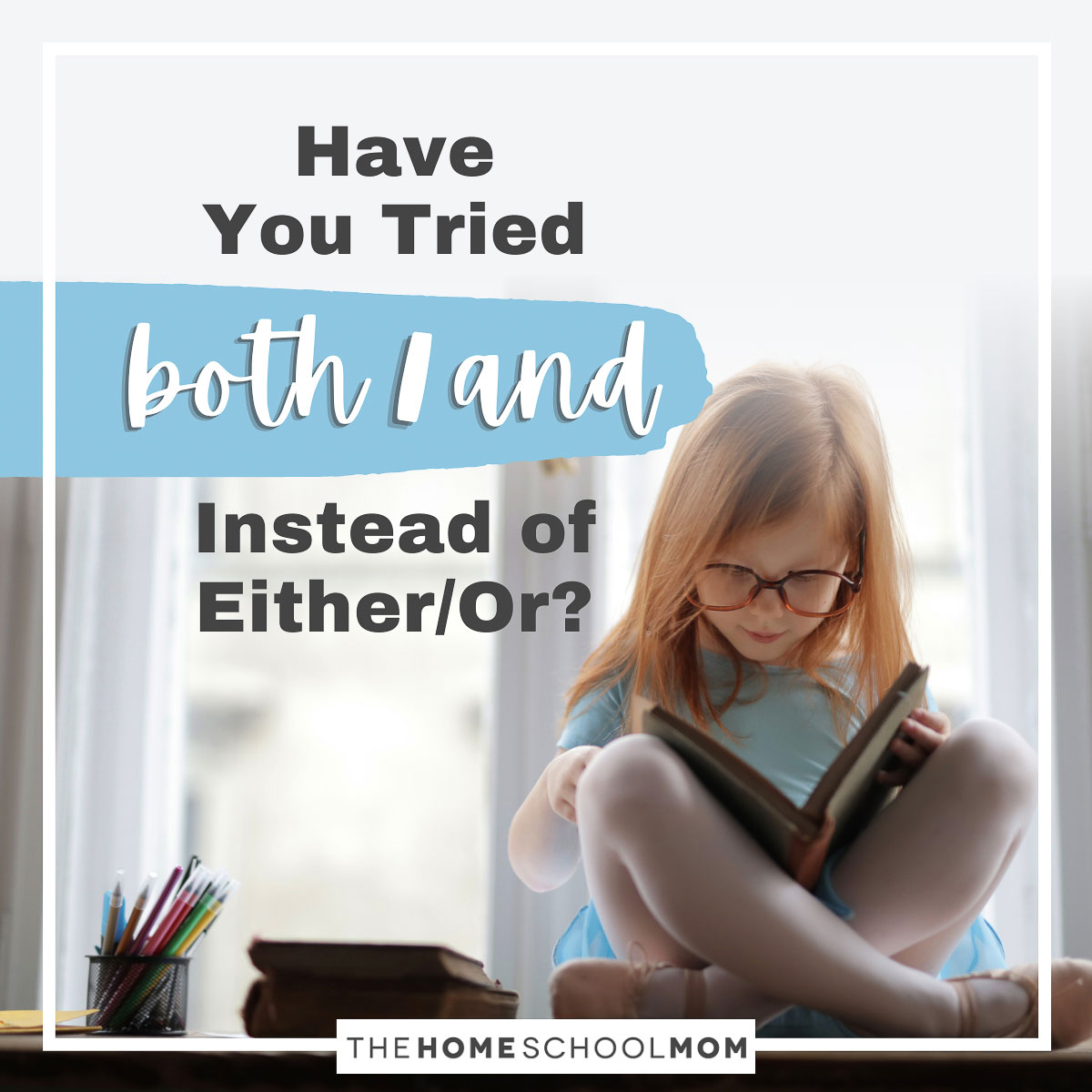The education pendulum swings, and homeschoolers often swing along with the trends of public schools.
I'm old enough to have heard the experts be sure of phonics then whole language then phonics again.
I've been through arithmetic, new math, and Common Core math.
Various approaches to education have experts in their corner, and the experts often draw the battle lines clearly. Their way is the way.
You do it their way, or you are doing it the wrong way. At least that's the perception.

But that doesn't have to be the case. Instead of an Either/Or approach, you can opt for a Both/And approach. Meaning, you can do both phonics and build a relationship with reading. You can do both arithmetic skills and math concepts. Your kids might benefit from both a linear approach to science and a topical approach.
The challenge of following educational experts-or feeling you will get it "wrong" if you don't follow them-is real.
For example, logic tells me that phonics is the only way for kids to learn to read. But one of my kids would have nothing to do with overt phonics instruction and burst into reading without a single lesson. Turns out that both phonics and whole language approaches helped my children read.
I remember being fussed at in school for counting on my fingers because the demands of arithmetic meant I should have all my math facts memorized. Thus, I would sneak and sit on my hands, pressing my fingers into the skin of my thighs, one by one, to help me calculate my way to becoming a strong math student.
I hear homeschool moms lament their children's finger counting, as I rush to supply info from brain research studies showing the benefits. Does that mean there is no benefit to learning math facts? Of course not! Both traditional memorization and activating the brain with finger-touches can help a child with math.
Teaching kids about scientific classification is logical and can be done with a linear approach. But one of my kids learned by exception. Reading and talking about the duck billed platypus taught him more about taxonomy than an organized lesson through kingdom, phylum, class, order, family, genus, and species. A mammal that lays eggs? That's a great way to learn about mammals. And eggs. And scientific classification! Both a linear approach to science and a topical one helped my kids learn science.
There are a lot of learning strategies.
There are a lot of teaching strategies.
Overt, logical, organized lessons are favored by schools, but they may not help kids develop a relationship with what they are learning about. On the other hand, some kids may feel abandoned in the pool if they are not first shown the steps that will keep them afloat. I'm here to remind you that both playing in the pool and taking swimming lessons can have value in creating swimmers.
Do you pick an educational "side" and stick with it?
Is it working for you?
Is it working for your kids?
Is your adherence to one "side" or the other of an educational approach getting in your own way?
In your kids' way?
What if it's okay to practice math facts both by playing Yahtzee and by using worksheets? Or what if it's okay for one kid to play math games, but your other kid wants the magic of memorization?
What if not insisting on reading lessons for kids who are turned off by phonics preserves their love of books? And what if helping (some?) kids systematically learn phonics works better for them?
Remember that many educational debates are framed as Either/Or, but you can choose Both/And. Don't back yourself in a corner by criticizing and excluding other methods that do indeed work for some people.
Some day, when your first choice methods aren't bringing progress and engagement, you might need to try other methods. You might even need to combine methods or try both and see what works! You might find a new way in addition to what worked for your firstborn, your sister's kids, your pastor's kids, and for you when you were a kid.
Homeschooling is humbling like that. My twenty years proved it!




 A popular speaker at homeschooling conferences, business groups, and parents’ groups, Jeanne Potts Faulconer homeschooled her three sons in North Carolina, Mississippi, and Virginia for twenty years. Holding her Master of Arts degree in Communication, Jeanne conducted portfolio evaluations for Virginia homeschoolers for evidence of progress for many years. Jeanne is a former college faculty member, former editor for several publications, news correspondent for WCVE, and former director of Brave Learner Home. She is the contributing editor for TheHomeSchoolMom newsletter and writes the popular Ask Jeanne column addressing homeschool parents' questions here at TheHomeSchoolMom.
A popular speaker at homeschooling conferences, business groups, and parents’ groups, Jeanne Potts Faulconer homeschooled her three sons in North Carolina, Mississippi, and Virginia for twenty years. Holding her Master of Arts degree in Communication, Jeanne conducted portfolio evaluations for Virginia homeschoolers for evidence of progress for many years. Jeanne is a former college faculty member, former editor for several publications, news correspondent for WCVE, and former director of Brave Learner Home. She is the contributing editor for TheHomeSchoolMom newsletter and writes the popular Ask Jeanne column addressing homeschool parents' questions here at TheHomeSchoolMom.
Leave a Reply